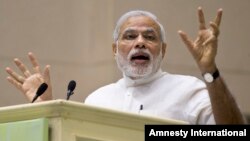Amid growing concerns that India is not doing enough to combat alarming levels of air pollution, Prime Minister Narendra Modi has launched a national air-quality index to monitor conditions in 10 major cities. The focus on air pollution came after the Indian capital surpassed Beijing in having the world’s most toxic air.
Using a global standard, the new air pollution index will track eight pollutants and use color coding to describe health impacts, with green denoting the cleanest and red the dirtiest air. That will make it easy for citizens in crowded cities like New Delhi, Bangalore and Chennai to assess air quality.
Launching the index in New Delhi, the prime minister said India must change the global perception that it does not care about the environment or climate change.
Changing lifestyles
Modi said that India has a long tradition of respecting the environment and can show the rest of the world the way in tackling this challenge.
Blaming changing lifestyles for the problem, he urged Indians to reduce waste and conserve resources as they become wealthier.
The alarming levels of air pollution have become a pressing concern for urban residents. The World Health Organization says that 13 of the world’s 20 most polluted cities are in India.
The worst is Delhi. Indian officials have disputed both findings, but experts say that the pollutants in the thick smog that hangs over the Indian capital in winter months can reach up to three times the acceptable limits on the worst days.
India’s toxic air is blamed on fumes from diesel vehicles that choke Indian cities, and smoke and dust from industrial and construction activity.
Doctors have warned that the rising levels of air pollution are fueling an increase in diseases such as asthma, chronic bronchitis and lung cancer.
The WHO calls air pollution a leading cause of premature deaths in India, with about 620,000 people dying of pollution related diseases every year.
Anumita Roychowdhury who heads the air pollution program at New Delhi’s Center for Science and Environment called the launch of the index a good first step in combating the severe problem. She said the next step should be for city governments to issue public health warnings and kick in contingency plans on days that pollution levels cross acceptable limits.
“In Beijing for instance, there are curbs on traffic, they shut down factories for a while, construction activity are brought to a hold," said Roychowdhury. "They do not allow 80 percent of the government vehicles to ply on the roads. Clearly there is a very strong action plan in place to reduce the severe pollution levels and that is what we need to move towards.”
Public awareness
Environment Minster Prakash Javedkar said he hopes the new index will give a major impetus to policies that can improve air quality by improving public awareness.
Roychowdhury said the new index could make it easier for governments to bring in difficult measures such as restrictions on private vehicles.
“Today even the government may find it difficult to push through many actions which require reducing dependence on personal cars for instance," said Roychowdhury. "But if people understand what air pollution is doing to their health, then all these hard decisions now we need to take, we can build public support on that.”
The index was launched at a two-day conference that includes environment and forest ministers from all Indian states. It will consider measures to strengthen green laws.
Over the next two years, the index will be expanded to about 66 cities with a population of more than 1 million people.







